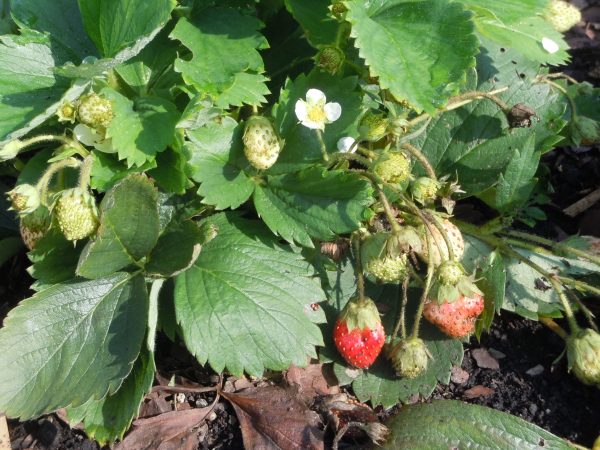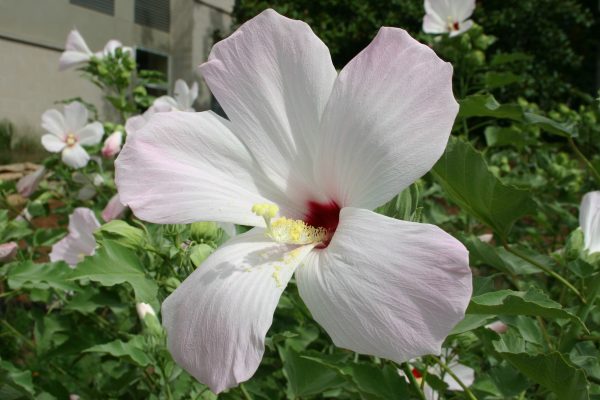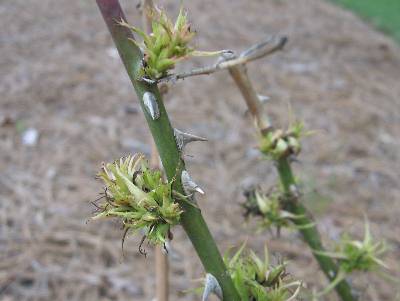Strawberry

Fragaria cv.
Growing your own Strawberries means that you can have the makings for a tasty treat, especially with short cake and ice cream, on a hot summer evening.
• More detailed information can be found in The Georgia Fruit & Vegetable Book by Walter Reeves and Felder Rushing
• See also Home Garden Strawberries
Georgia Vegetable Gardening Publications
Strawberries respond to good treatment and reward your time and effort with plenty of high-quality fruit. Neglect them and the berry patch will rapidly deteriorate. You can choose from 3 types of Strawberries: June-bearing types produce a heavy crop for 2 or 3 weeks in June; everbearing types produce 3 crops per season, a crop in June, in midsummer and in fall; and day-neutral types produce flowers and fruit all season. To have sufficient berries at one time for freezing or preserves, grow June-bearing types. To have fresh berries all summer, choose everbearing or day-neutral varieties.
WHEN TO PLANT
Plant Strawberries in fall or in early spring as soon as the soil dries enough to be workable. Do not try to plant in wet soil. Early planting allows the plants to become established before the arrival of hot weather.
WHERE TO PLANT
Well-drained soil and full sun (8 to 10 hours will suffice) are essential for growing Strawberries. Although Strawberries will grow in shade, the production will be severely reduced and diseases can become a major problem. Good air circulation is essential. Make sure the bed is not sheltered by a fence, shrub beds, or other taller garden plants. The bed will be in place for 3 years or more, so locate it where it will not be disturbed and will not interfere with other gardening operations. Strawberries are susceptible to verticillium wilt, a fungus disease that infects the soil and plants growing in it. Do not plant Strawberries where potatoes, tomatoes, peppers, etc. have been grown in the last 5 years.
HOW TO PLANT
Prepare the soil as you would for a vegetable garden. Be sure to kill off perennial weeds such as Bermuda grass or nutgrass using a non-selective herbicide. Till the soil to make a fine seedbed, making sure the soil is finely broken up. If you do this work in the fall, the soil will dry more quickly and allow planting earlier in the spring. Buy certified virus-free plants if possible. When plants arrive from the supplier, protect them from drying out until you can plant them by refrigerating them or heeling them in. If wrapped in plastic they will keep in the refrigerator for up to a week. To heel-in the plants, find a protected place, dig a furrow deep enough to cover the roots of the plants, lay the plants in the furrow, cover the roots with topsoil and then water. Plants can stay heeled-in for several days.
Because of diseases, two very different production systems are used in the Southeast. In the Matted Row System, plants are set out one spring and fruit the next. This system works best in Zones 7a and cooler and production may continue for several years. In the Annual Hill System, plants are set out in the fall and fruit the next spring. The planting is usually destroyed after the crop is harvested. This system works best in Zones 7b and warmer.
MATTED ROW SYSTEM
The matted row system involves planting the mother plants 2 feet apart the first spring, then letting runners fill the bed the first summer. The flowers are removed the first year, so no fruit is produced until the second year. An area approximately eight feet wide and 30 feet long will be needed to produce plenty of berries for a family of four for year-round use. Thirty plants will be needed to start the bed.
About a week before planting, broadcast 5 pounds of 10-10-10 over the 8 x 30 foot area where the Strawberries are to be planted. Till the soil and smooth the bed. Allow the soil to be settled by a rain before planting. When soil moisture conditions are ideal for planting (the soil is not wet), lay off two rows that are 4 feet apart. Each of the rows should be 2 feet from the edge of the bed. Set the plants 2 feet apart in the rows (you will need 30 plants for the bed). Set the plants so the top of the crown is just above the soil line.
A couple of weeks after the new plants begin to grow, flowers will appear. Remove these flowers the spring of the first year to allow strong plant development to occur. During the summer of establishment, allow the Strawberry runners to develop to form the matted row.
Fertilize the bed twice during the first summer. Broadcast 4 pounds of 10-10-10 over the bed in mid-June and again in late September. Always apply fertilizer to the plants when the foliage is dry and sweep the plants with a broom or leaf rake immediately following the application. If the soil is extremely sandy, it may be beneficial to fertilize the bed using the above rates in late-May, mid-July and early October. The desired result the first growing season is to develop matted rows 2 feet wide with a 2-foot walk space between the rows. If the planting is vigorous, you will probably have to cut runners that grow into the middle aisle.
During the winter and spring months, periodically check the planting for the development of winter weeds that should be removed. In the late winter of second and subsequent years (mid-February to mid-March broadcast 4 pounds of 10-10-10 fertilizer over the bed. Following fertilization, mulch the bed with a layer (1 to 2 inches) of pine straw before growth begins. Rake most of the straw off the tops of individual plants. The Strawberry plants will grow up through the straw, and the straw will help keep the berries from getting soiled.
RENOVATE AFTER HARVEST The day you finish picking the crop for the year is the day you should get the bed into good shape for the next season. This is in late May to late-June, depending on where you live. If it happens to be too wet to till, wait a few days. To renovate the matted rows, mow the leaves from the Strawberry plants. Be sure that you mow them high enough so that the lawn mower blade does not damage the crowns. Next, narrow the 2-foot wide mats with a tiller or turn the soil with a shovel so that the remaining strip of plants is about 8 inches wide. Save mostly the young plants instead of the original mother plants. If you don’t get rid of two-thirds of the plants by tilling, then you’ll have too many plants for next year. After tilling is completed, rake out as many of the plants in the tilled area as possible and smooth the soil surface. Broadcast over the bed 4 pounds of 10-10-10 fertilizer and turn the sprinkler on. One-half to 1 inch of water should be applied immediately following renovation in the form of rainfall or irrigation. If the bed is still in good condition after two picking seasons, renovate again after harvest and follow the second season recommendations so you’ll enjoy berries from the same bed a third year. If you start a new planting, move it to another area since you may have a disease and/or nematode buildup. Matted row Strawberry plantings usually last only 2 or 3 years. Then the production goes down and disease problems show up. Some gardeners overcome this problem by planting a bed on one side of the garden 1 year and on the other side the next year. While one is in production, the other is becoming established.
CARE AFTER RENOVATION Be sure to keep the bed free of weeds and irrigate if the rain is insufficient. Strawberries need 1 to 1 1/2 inches of water per week. Fertilizer should be applied two more times during the second and subsequent growing season. In mid-July, broadcast 3 pounds of 10-10-10 fertilizer over the bed. The last application should be applied in mid to late September by broadcasting 4 pounds of 10-10-10 fertilizer over the bed. Don’t forget to apply when the foliage is dry, and sweep the leaves free of fertilizer. By late September, the matted rows should again be 2 feet wide. Be sure to remove plants that grow into the aisle in late summer.
WINTER AND SPRING CULTURE (Third and subsequent years) Check for weeds and remove any that are present. Fertilize using the same rate and timing as you used the previous winter. Don’t forget to mulch and keep your eyes open for fruit rots, particularly during wet weather, and also insects that may eat the fruit or foliage.
ANNUAL HILL SYSTEM – ESTABLISHMENT
In Zones 7b and warmer Strawberry plants can be set in the fall and harvested the next spring. This reduces the danger of diseases destroying your crop. The Chandler variety is by far the best for the hill system but other June-bearing varieties will produce mediocre to fair results. Plants are set 12 inches apart in the row and 12 inches apart between rows on beds that contain two rows. The beds should be 6 inches high at the shoulder and 8 inches high in the center and 26 inches wide. An aisle 22 inches wide between beds should be provided as a place to walk. Before making the beds, broadcast fertilizer over the plots. Spade in 3 pounds of 10-10-10 per 100 square feet of bed. Best results are usually obtained by mulching the bed with black plastic. An optional drip irrigation tube can be placed under the plastic. Apply the plastic before planting. Be sure the bed is well formed, firm, fertilized and very moist. Set plants from September 15 to November 15 (usually October is the best month). Freshly dug plants are planted and watered intensively for the first week after planting. Potted plants can also be used and require less watering to establish. If the planting is initially anthracnose disease free, it may live for several years and can be managed as a matted row system. Cut holes in the plastic to allow the runners to peg down. Contact your county Extension office if you cannot find plants at a local nursery.
Everbearing and day-neutral Strawberry varieties can be grown successfully in Strawberry pots or other containers. Place 1 plant in each opening in a Strawberry pot; place 2 or 3 plants in a large pot. Use a high quality potting soil. Take care to cover the roots with soil but if the crown is buried, it will rot. If the roots are exposed, they will dry out. Water the planting thoroughly to settle the soil.
PESTS
You will have few problems with growing Strawberries if you start with disease-free plants and provide adequate air circulation and water. If a planting does develop serious diseases, replace it. Your local Extension office can provide you with a spray schedule for specific pests and diseases.
Because there is not much food available for birds when Strawberries ripen, birds can be a serious problem. The most effective method to keep them from getting most of the fruit is to cover the planting with bird netting. The net will have to be anchored all the way around the planting, otherwise the birds will walk under it. To anchor the net, place 6- to 8-inch stakes around the planting every 2 feet. Angle the stakes out away from the rows so that the net can be hooked over the stakes. This will keep the edge of the net close to the ground, and keep the birds from getting under the net. It takes only a few minutes to remove the net for picking, and to replace it after you are through.
Fruit – 2020 Homeowner Spray Guide
ADDITIONAL INFORMATION
Strawberries in Zones 7a and colder need winter protection. Covering them with straw is one way to do it. After several good freezes, apply clean straw 3 to 4 inches deep over the plants. If winter winds blow the straw off, rake it back. In the spring, begin to remove the straw when daytime temperatures are consistently in the 40-degree Fahrenheit range. Be prepared to reapply it if a late-season frost is predicted. The freezing of open flowers means that the berries will be killed. Other means of protecting blooms from frost include covering the planting with old sheets or blankets, light-weight polyester row covers or running the lawn sprinkler all night to keep free water on the plants. The plants may have ice on them but the flowers will not freeze as long as there is free water on them too.
Strawberries are ready for harvest about 30 days after the first bloom. Harvest the berries when they are fully red. Do not allow them to stay on the plants when fully ripe or something else will harvest them for you. Any spoiled berries must be picked off the plants to avoid rotting, which could spread to other berries. Snap the berries off with the cap and a small piece of stem attached, using your thumbnail if necessary.
VARIETIES
Catalogs list so many varieties that determining how a variety will grow in your yard is difficult. Select some varieties that sound promising and try a few of each to see how they perform. After some trials, you will be able to select varieties that do what you want in your garden. Your county Extension office may be helpful in selecting varieties that do well in your particular locality.
Strawberries ripen between 30 and 45 days after flowering. June-bearing types can be expected to bear from early June to as late as early July if the weather is cool. Everbearing and day-neutral kinds will flower and fruit throughout the season with the first harvest about the same time as June-bearing kinds.
June-Bearing Strawberries
Varieties
Comments
Chandler
high yield, good fruit color, excellent flavor.
Florida 90
good for Zones 7b and warmer
Surecrop
Large fruit, good disease resistance.
Earliglow
Early, good disease resistance.
Honeoye
Large fruit, hardy, good for freezing
Apollo
Good-size, firm, flavorful, tolerant of leaf diseases.
Sparkle
Late, excellent flavor.
Everbearing and Day-Neutral Strawberries
Varieties
Comments
Ft. Laramie
Tolerates severe winters with protection.
Gem
Also known as Superfection; good production.
Ogallala
Good cold tolerance with protection.
Ozark Beauty
Late, very productive
Tribute
Late, good disease resistance, late
Tristar
Early, resistant to verticillium and red stele











